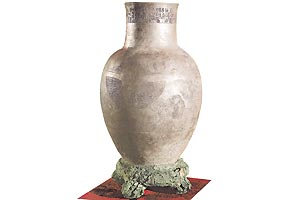We tend to believe that the name Mesopotamia stands for one single civilization, yet the actual meaning is «country or region between rivers.» The name designates a group of cultures that successively flourished in the land flanked by the rivers Tigris and Euphrates and the surrounding area bordered by the Anatolian mountains to the north, the Iran mounts to the east, the sea (Persian Gulf) to the south and the desert to the west. Today, this territory encompasses parts of Syria, Turkey, Iran, and almost the whole of Iraq, although there were times when these peoples occupied a larger area.
Researchers have concluded that the first human settlements in Mesopotamia date back to 10,000 B.C., and that oat farming began in today’s northern Iraq around 8,000 B.C. Agriculture became a common practice about 7,000 B.C., thus paving the way to sedentarism.
The earliest civilization
The Sumerians arrived in southern Mesopotamia during the fourth millennium B.C., presumably from India or central Asia.
Their first task was to tame the floods resulting from the violent rise of rivers Euphrates and Tigris during the months of April and May as a consequence of the spring thaw in the mountains of Armenia. As a way to prevent river overflow and secure water supplies for the whole year, they built dams and irrigation canals towards the areas they wanted to cultivate.
They also invented the wheel around 3,500 B.C. But their biggest contribution came between 3,500 and 3,100 B.C. in the form of cuneiform writing, the breakthrough that marks the end of Prehistory and the beginning of History.
The Sumerian period had its height towards 3,100 B.C. They founded cities that ruled themselves as independent states, the main one being the city of Ur.
Each city had a temple to honor the local god that also served as the political, religious and economic center. In addition to their worldly duties, the rulers or patesi represented God as supreme priests.
Great traders
In order to obtain the products they lacked -stones, copper, gold and silver-, the Sumerians traded with other peoples. Trade initially consisted of barter or exchange of merchandise, but later they used gold and silver bars to pay for the products.
Sumerian traders reached the territories that are now part of Asia Minor, southern Russia and India.
Their multiple gods
The inhabitants of Mesopotamia were polytheists, that is, they adored many different gods.
The cult of stars, planets and the forces of nature began some time around the year 4,000 B.C. The most important deities were:
– Sin, the Moon, lord of time and the months. The Sumerians divided the year into 12 months with 7-day weeks, in accordance with the moon cycles.
– Shamash, the Sun, god of the oracle and justice, and son of the moon god.
– Ishtar, planet Venus, was the goddess of lover, fertility and war.
Starting 3,000 B.C., Sumerians began representing their gods with human figures and clearly defined their different attributes and roles.
The great amount of deities has led specialists to believe that each city-state (Uruk, Ur, Eridu, Kish, Lagash, Nippur) had its own gods. Once the different cities were unified under the rule of the peoples that subsequently settled down in the region, they apparently tried to organize their beliefs and deities, but they only managed to put them together without any clear order.
On the other hand, the gods of the Semitic peoples that succeeded the Sumerians in Mesopotamia were organized into a monarchic hierarchy. Thus, Marduk in Babylonia and Assyrian god Ashur imposed themselves over the cosmic deities of the early Sumerians.








 Muere Evita
Muere Evita